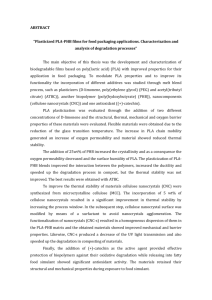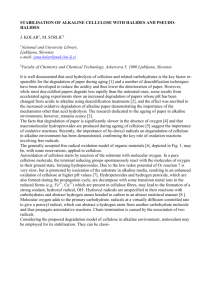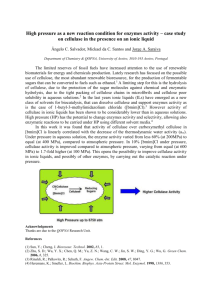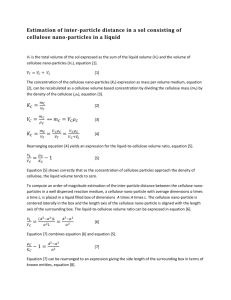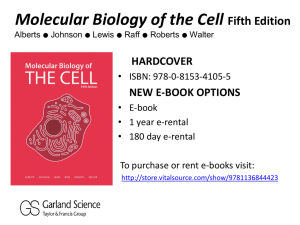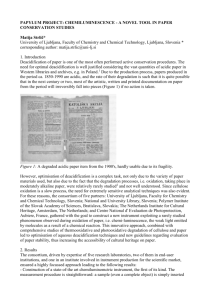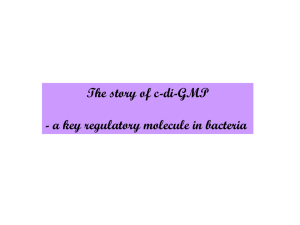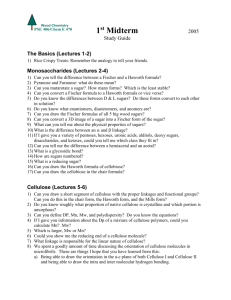Bagniuk et al, INNOVATIVE APPROACHES FOR ANCIENT PAPER
advertisement
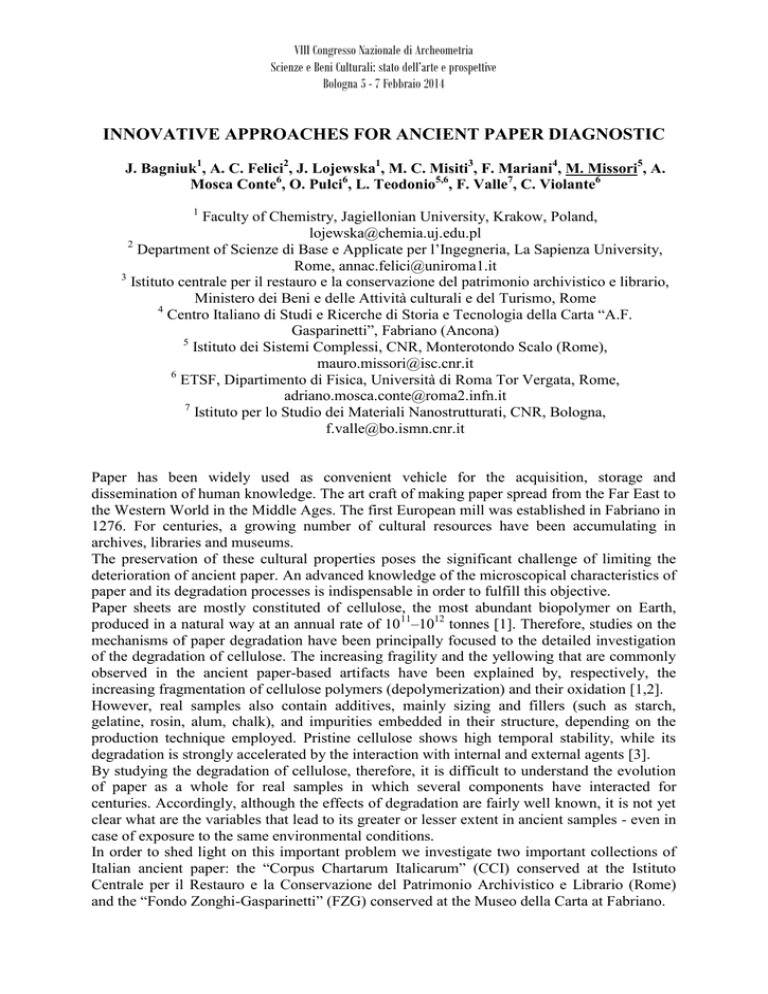
VIII Congresso Nazionale di Archeometria Scienze e Beni Culturali: stato dell’arte e prospettive Bologna 5 - 7 Febbraio 2014 INNOVATIVE APPROACHES FOR ANCIENT PAPER DIAGNOSTIC J. Bagniuk1, A. C. Felici2, J. Lojewska1, M. C. Misiti3, F. Mariani4, M. Missori5, A. Mosca Conte6, O. Pulci6, L. Teodonio5,6, F. Valle7, C. Violante6 1 Faculty of Chemistry, Jagiellonian University, Krakow, Poland, lojewska@chemia.uj.edu.pl 2 Department of Scienze di Base e Applicate per l’Ingegneria, La Sapienza University, Rome, annac.felici@uniroma1.it 3 Istituto centrale per il restauro e la conservazione del patrimonio archivistico e librario, Ministero dei Beni e delle Attività culturali e del Turismo, Rome 4 Centro Italiano di Studi e Ricerche di Storia e Tecnologia della Carta “A.F. Gasparinetti”, Fabriano (Ancona) 5 Istituto dei Sistemi Complessi, CNR, Monterotondo Scalo (Rome), mauro.missori@isc.cnr.it 6 ETSF, Dipartimento di Fisica, Università di Roma Tor Vergata, Rome, adriano.mosca.conte@roma2.infn.it 7 Istituto per lo Studio dei Materiali Nanostrutturati, CNR, Bologna, f.valle@bo.ismn.cnr.it Paper has been widely used as convenient vehicle for the acquisition, storage and dissemination of human knowledge. The art craft of making paper spread from the Far East to the Western World in the Middle Ages. The first European mill was established in Fabriano in 1276. For centuries, a growing number of cultural resources have been accumulating in archives, libraries and museums. The preservation of these cultural properties poses the significant challenge of limiting the deterioration of ancient paper. An advanced knowledge of the microscopical characteristics of paper and its degradation processes is indispensable in order to fulfill this objective. Paper sheets are mostly constituted of cellulose, the most abundant biopolymer on Earth, produced in a natural way at an annual rate of 1011–1012 tonnes [1]. Therefore, studies on the mechanisms of paper degradation have been principally focused to the detailed investigation of the degradation of cellulose. The increasing fragility and the yellowing that are commonly observed in the ancient paper-based artifacts have been explained by, respectively, the increasing fragmentation of cellulose polymers (depolymerization) and their oxidation [1,2]. However, real samples also contain additives, mainly sizing and fillers (such as starch, gelatine, rosin, alum, chalk), and impurities embedded in their structure, depending on the production technique employed. Pristine cellulose shows high temporal stability, while its degradation is strongly accelerated by the interaction with internal and external agents [3]. By studying the degradation of cellulose, therefore, it is difficult to understand the evolution of paper as a whole for real samples in which several components have interacted for centuries. Accordingly, although the effects of degradation are fairly well known, it is not yet clear what are the variables that lead to its greater or lesser extent in ancient samples - even in case of exposure to the same environmental conditions. In order to shed light on this important problem we investigate two important collections of Italian ancient paper: the “Corpus Chartarum Italicarum” (CCI) conserved at the Istituto Centrale per il Restauro e la Conservazione del Patrimonio Archivistico e Librario (Rome) and the “Fondo Zonghi-Gasparinetti” (FZG) conserved at the Museo della Carta at Fabriano. VIII Congresso Nazionale di Archeometria Scienze e Beni Culturali: stato dell’arte e prospettive Bologna 5 - 7 Febbraio 2014 Using these unique collections we seek for correlations between indicators of degradation (depolymerization and oxidation) and variables that may impact the long-term stability of paper materials such as the content of metals and nonmetals, the presence of surface coating (sizing), the porosity of the substrate, thickness, basis weight, and historical and geographical data [4]. Due to the historical value of specimens belonging to the CCI and FZG collections, only nondestructive diagnostic methods have been used, a distinctive feature with respect to previous studies [4]. In the presentation, innovative approaches for quantitative measurements of cellulose oxidation [5], paper sheets elemental content and surface structures will be shown. Our results will possibly enable the improvement of procedures for the conservation and restoration, and could be used in other context for cellulose-based materials, like industrial paper, textiles and other manufactured products of great technological and cultural interest. References [1] Krassig, H. A., 1993. Cellulose - Structure, Accessibility and Reactivity, Gordon and Breach Science Publisher, Singapore. [2] Missori, M., Righini, M., Selci S., 2004. Optical reflectance spectroscopy of ancient papers with discoloration or foxing. Opt. Commun., 231: 99-106. [3] Zervos, S., 2010. Natural and accelerated ageing of cellulose and paper: A literature review. In: Cellulose: Structure and Properties, Derivatives and Industrial Uses, ed. Lejeune, A. & Deprez, T., Nova Publishing, New York, 155–203. [4] Stephens, C. H., Barret, T., Whitmore, P. M., Wade, J. A., Mazurek J. and Schilling, M., 2008. Composition and condition of naturally aged papers. Journal of the American Institute for Conservation 47, 201-215. [5] Mosca Conte, A., Pulci, O., Knapik, A., Bagniuk, J., Del Sole, R., Lojewska, J., and Missori, M., 2012. Role of cellulose oxidation in the yellowing of ancient paper. Phys. Rev. Lett., 108: 158301.



